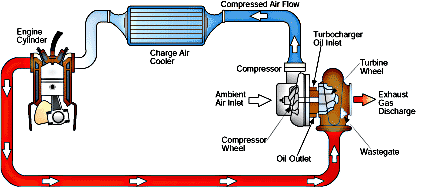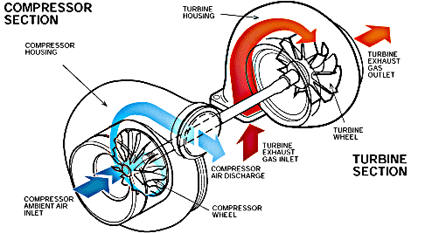How a turbo-charger works:-
Many people reading about the Concept IC Engine would have seen the similarity between this design and that of a turbocharger, so how is it different ? Well there are a lot of differences the most important of which is that the turbocharger taps into the energy from the exhaust after most of the energy has already been expended while the Concept IC Engine uses these energies when they are at near peak levels. Secondly in an ordinary engine using a turbo charger the exhaust gases are dissipated due to valve design , therefore any thrust which might be gained from the ejection of these hot gases is dissipated or directed side wards into the cylinder walls. In the Concept IC Engine , the thrust created by the explosive ejection of hot gases at velocity is enhanced by the use of a venturi or nozzle and also directed so as to gain maximum thrust from the escaping gases in the downward motion of the piston. Thus although , pressure in the piston when the exhaust valve is fully opened at 80 degrees to 90 degrees before BDC might immediately come to zero , it is compensated to a large extent by the thrust generated. This is where recoilless technology comes into play. (See article on recoilless energy.)
However valve design and the utilisation of thrust created by exhaust gases escaping at velocity is only the most obvious difference between turbo charger and the Concept IC engine there are several other fundamental differences.
If one examines Figure 1. Which is a diagram of a turbocharger layout in a typical engine , it is immediately possible to see that energy from the exhaust is not being fully utilised , they have to travel a long distance before actually powering the turbine and also that the poppet valves used do not allow for generation of thrust from the exhaust gases.
 Figure 1. The other fundamental difference between a Concept IC Engine and a turbocharger is that in a turbo charger the compressor fan and the turbine fan are in separate housings connected by a common shaft , thus the compressor is used solely is used solely for increasing the air intake of the piston unit. See Figure 2. Figure 2.  In a Concept IC Engine the compressor is used to bring in air and compress it prior to being heated and used to actually turn the main turbine , so that the turbine in a Concept IC Engine works in an almost identical fashion to the turbine engine as used in car engines or jet planes. (See article on turbine engine.)
It can therefore be seen that the turbine unit in a Concept IC Engine is capable of developing about 250 horse power which in turn can be used to run a generator which would feed electricity to separate motors at each rear wheel in the manner of a diesel electric engine. The main piston unit can also be used to run a generator and supply electricity , this would mean that the transmission is to a large extent eliminated. In whatever way the power developed by a Concept IC Engine is used , the most important thing to remember is that the power is there to be tapped in anyway in which it is convenient to use. The exhaust from such an engine would have zero pollution because of the large amounts of air to fuel ratio which are used. It is very important that those who wish to gain a true understanding of the working of the Concept IC engine that they read the article on turbine engines. (See article on turbine engines.)
|



